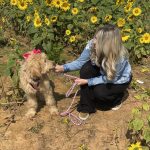UNDERSTANDING AND MANAGING FALL PET BEHAVIOR CHANGES
As the cool, crisp air of autumn settles in and the days grow shorter, pet owners may notice changes in their furry companions’ behavior. These changes are influenced by various factors including; temperature fluctuations, reduced daylight and seasonal environmental shifts.
As the leaves change color and temperatures drop, you may observe some of the following shifts in your pet’s behavior:
- Increased Energy – Many pets, particularly dogs, become more active in cooler weather.
- Altered Eating Habits – Some pets may experience changes in appetite, either eating more due to increased activity, or less because of cooler temperatures.
- Cozier Nesting – Cats and small dogs might seek out warm, cozy spots indoors, near heating vents and/or sunny windows.
- Anxiety or Restlessness – Reduced daylight can trigger anxiety or restlessness in your pet, especially those who may be prone to Seasonal Affective Disorder (SAD).
REASONS BEHIND FALL BEHAVIOR CHANGES
Understanding the reasons behind these behavioral shifts can help pet owners empathize with their pets and address their needs effectively. Key factors contributing to fall behavior changes in pets include:
- Cooler temperatures can make pets more energetic, especially if they have been cooped up during the hot summer months.
- Reduced daylight can affect a pet’s internal clock, leading to changes in sleeping patterns and mood.
- Seasonal allergies can add to a pet’s discomfort.
- Environmental changes, such as falling leaves, wildlife and other autumnal scents can pique a pet’s curiosity or trigger territorial behavior.
MANAGING YOUR PET’S FALL BEHAVIORAL CHANGES
To ensure your pet remains happy and healthy during the fall season, consider these practical tips:
- Stick to a routine with feeding, exercise and playtime to provide stability (this will also help pet owner’s suffering from seasonal depression).
- Spend time playing outdoors with your pets. Aim for walks and play sessions to soak in the benefits of fresh air and natural light.
- Engage your pet with interactive toys, puzzles and games to combat restlessness during shorter daylight hours.
- If your pet’s appetite changes, consult your veterinarian to ensure there is no underlying medical condition, and that their nutritional needs are being met.
- Keep an eye out for signs of allergies, such as itching or sneezing, and consult your veterinarian for proper treatment.
- Offer safe, warm and comfortable spots for your pet to sleep and relax, both indoors and outdoors.
- Maintain your pet’s exercise routine. If you are struggling with this, hire a professional dog walker.
- If your pet’s anxiety or restlessness persists, consult a professional trainer or animal behaviorist for guidance (assuming no underlying health condition).
SIGNS OF SEASONAL AFFECTIVE DISORDER (SAD)
While it is less common in pets, some animals may experience SAD during the fall and winter months. Signs of pet SAD can include lethargy, increased appetite and withdrawal from social interaction.
PREPARING FOR SEASONAL HAZZARDS
As fall brings new environmental elements, it’s crucial to safeguard your pet from potential hazards. Fallen leaves, while beautiful, can hide dangers such as sharp objects or toxic substances. Keep your yard clear of debris and be vigilant during walks.
Halloween decorations and treats should be kept out of reach, as chocolate and certain decorations can be harmful to pets. Refer to our Happy Halloween blog for more information.
Additionally, with the approaching holiday season, be cautious about plants that can be toxic to pets. Be sure to check out our blog, Toxic Substances to Pets, for an extensive list!
CONCLUSION
Ultimately, fall is a season of change and adaptation, not only for humans, but also for our beloved pets. By observing your pet’s needs and providing them with the support and care they require, you can both relish the beauty and magic of this unique time of year.
Whether you are strolling through autumnal landscapes, cuddling up on a warm blanket or simply enjoying quiet moments together, the fall season can strengthen the bond between you and your furry friend.











